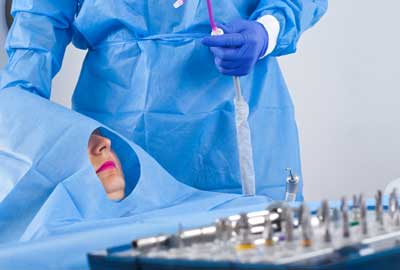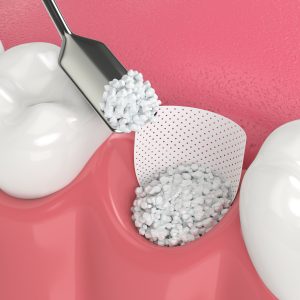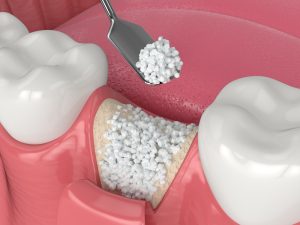Bone Grafting in Rosenberg, TX
Revitalize Your Smile with Dental Implants and Bone Grafting in Rosenberg
Are you tired of the negative effects of tooth loss, such as jawbone deterioration and a sunken smile? Our team at Rosenberg Dental and Implant Center has the perfect solution: dental implants. Experience the transformative power of dental implants, the ultimate fix for missing teeth. But here’s the key to success: precise procedures with bone grafting from Rosenberg, TX implant dentist, Dr. Samuel Collins.
By strengthening a weak jaw bone, we can create a solid foundation for implants, significantly reducing the risk of surgery failure. Learn more by dialing (281) 369-9242 or read the helpful guide below.
Request An Appointment

What is Bone Grafting?
Bone grafting, also known as bone augmentation, builds up the bone structure using natural bone material or synthetic bone graft. It is a minor surgical procedure done under local anesthesia. When you use a tooth or get a tooth extraction, the bone around the empty tooth socket begins to resorb. It may take a few months or years before extensive bone loss occurs. If you are considering dental implants, you need to have a thick bone to retain them.
Schedule your service appointment!
Benefits of Bone Grafting
- Improved Implant Success: Bone grafting creates a strong and stable foundation for dental implants, increasing the success rate of implant placement, even in cases of reduced bone density.
- Preservation of Jaw Structure: These procedures prevent or reverse bone loss, preserving the natural contours of the jawbone and facial structure after tooth extraction or bone resorption.
- Enhanced Aesthetics: Restoring bone volume can lead to improved facial aesthetics, preventing a sunken appearance associated with severe bone loss.
- Versatile Solutions: Bone grafting can be tailored to address various dental issues, from sinus lifts for upper jaw implants to ridge augmentation for extensive bone reconstruction.
- Long-Lasting Results: With proper care, bone grafting treatments provide long-term benefits, supporting the longevity of dental restorations and maintaining oral health.
What Are The Types of Bone Grafts?
Depending on the severity of bone loss and other factors, our Rosenberg implant dentist will decide which type of dental bone grafts will be most suitable for you. Dental bone grafting utilizes four different types of bone grafts, which include:
- Autografts: These grafts are derived from the areas of your own body, such as the chin, jaw, hip bone, etc. Autografts can be used for major or minor reconstructive surgeries.
- Alloplasts: These are biocompatible grafts derived from synthetic sources.
- Allografts: These grafts are obtained from other human donors, such as a bone bank.
- Xenografts: These bone grafts are obtained from other animals, usually a bovine (cow).
Types of Bone Grafting Procedures
Sinus Lift
A sinus lift is a surgical procedure that elevates the sinus membrane in the upper jaw to create additional space for dental implants. It is often performed when the sinuses are too close to the jawbone, impeding the implant placement process. By lifting the sinus and adding new bone graft material, this procedure ensures a strong foundation for dental implants in the upper jaw, allowing for secure tooth replacement.
Ridge Augmentation
Ridge augmentation, also known as ridge preservation or ridge reconstruction, is a dental procedure used to restore and rebuild the jawbone’s natural contour and density after tooth extraction or bone loss. This procedure involves placing bone graft material in the socket where a tooth was removed, ensuring the bone remains healthy and provides adequate support for dental implants or other restorative treatments.
Nerve Repositioning
Nerve repositioning, or inferior alveolar nerve repositioning, is a surgical technique used when the inferior alveolar nerve, responsible for sensation in the lower jaw and lower lip, impedes dental implant placement. During this procedure, the nerve is carefully repositioned to create space for the implants. Nerve repositioning is crucial in ensuring patient comfort and safe implant integration in the lower jaw.
Socket Preservation
Socket preservation is a dental procedure designed to maintain the natural shape and volume of the jawbone following tooth extraction. Unlike ridge augmentation, which reconstructs a partially lost or damaged ridge, socket preservation focuses on preventing bone loss by immediately filling the extraction socket with bone graft material. This technique helps preserve the bone’s integrity and density, creating an ideal foundation for future dental implant placement.
Who Qualifies for Dental Bone Grafting?
Dental bone grafting is recommended for individuals who:
- Require Dental Implants: Patients with insufficient natural bone to support dental implants, which are a popular tooth replacement solution, may require bone grafting to create a stable foundation for implant placement.
- Undergo Tooth Extractions: Individuals who have undergone tooth extractions, especially in areas where future dental implants are planned, can benefit from bone grafting to preserve and maintain the jawbone structure.
- Suffer from Bone Loss: Patients with pre-existing bone loss due to gum disease, trauma, or other oral health conditions may need bone grafting to restore bone density and structure.
- Desire Improved Aesthetics: Those seeking aesthetic enhancements, such as ridge augmentation to correct a sunken appearance following tooth loss, can be candidates for bone grafting to enhance their facial aesthetics.
- Wish to Avoid Denture Discomfort: People experiencing discomfort from ill-fitting dentures may opt for bone grafting to improve the stability and retention of implant-supported dentures.
- Seek Better Oral Health: Patients with oral health issues related to insufficient bone support may benefit from bone grafting to address these concerns and maintain overall dental health.
The Dental Bone Grafting Process
Consultation
The journey of dental bone grafting typically begins with an in-depth consultation at Rosenberg Dental and Implant Center. During this initial meeting, our experienced dental professionals will evaluate your specific oral health needs and discuss the bone grafting procedure.
This is a vital step for you to gain a comprehensive understanding of the process and address any questions or concerns you may have. We’ll ensure you are well-informed and comfortable before proceeding.
Preparation
On the day of your bone grafting procedure, we start by administering a local anesthetic to the treatment site. This ensures you experience minimal discomfort during the procedure. Once the tissues are sufficiently numb, we proceed by making a small incision along the gum line at the targeted area. This incision allows access to the underlying bone, where the graft will be placed. Our dental team takes precise measures to ensure the procedure is as painless as possible.
The Bone Grafting Procedure
The core of the bone grafting procedure involves the strategic placement of the prepared bone graft material. Our skilled implant dentist carefully positions the graft in the desired region to provide essential support for future dental implants or preserve bone structure.
To encourage the growth of healthy bone tissue, we introduce tissue regeneration factors into the treatment site. These growth factors stimulate the natural regrowth of bone, optimizing the graft’s integration with the existing bone.
Closure and Recovery
Once the graft is securely in place, we suture the incision line with great care. This meticulous closure ensures proper healing and minimizes the risk of infection. Following the procedure, you will be given post-operative instructions to facilitate a smooth and successful recovery.
It’s essential to allow time for the graft to fuse with your existing bone, which typically takes several weeks. Our dedicated team is here to support you throughout the recovery process, addressing any concerns and monitoring your progress to ensure the best possible outcome.
Dental Bone Grafting Aftercare
After your dental bone grafting procedure at Rosenberg Dental and Implant Center, it’s crucial to follow a well-structured aftercare plan to ensure a successful and smooth recovery from dental bone graft surgery. Here are the essential guidelines to help you achieve the best possible outcome:
- Oral Hygiene: Maintain excellent oral hygiene to prevent infection and promote healing. Continue to brush your teeth gently, but avoid the surgical area for the first few days. Rinse your mouth with a prescribed or mild saltwater solution as recommended by your dentist.
- Pain Management: You may experience some discomfort or mild pain after the procedure. Over-the-counter pain medications or any prescribed medications should be taken as directed by your dentist to manage pain effectively.
- Swelling and Bruising: Swelling and bruising around the surgical site are common and should subside within a few days. Applying an ice pack in intervals during the first 24 hours can help reduce swelling.
- Diet Modification: For a short period following the procedure, stick to a soft diet. Avoid hard, crunchy, or excessively hot foods that may irritate the surgical site. Opt for cool and soft options like yogurt, mashed potatoes, and smoothies.
- Smoking and Alcohol: Avoid smoking and consuming alcohol for a specified period, as they can impede the healing process and increase the risk of complications.
- Medications: Take any prescribed medications as instructed by your dentist. This may include antibiotics or antimicrobial rinses to prevent infection.
- Activity Level: Refrain from strenuous physical activities for a few days following the procedure to minimize the risk of bleeding and complications.
- Follow-Up Appointments: Attend all scheduled follow-up appointments with your dentist to monitor the progress of your healing and ensure the graft is integrating as expected.
- Oral Rinses: Use any prescribed oral rinses according to your dentist’s recommendations. These rinses can help keep the surgical site clean and aid in healing.
- Contact Your Dentist: If you experience excessive bleeding, severe pain, prolonged swelling, or any other concerning symptoms, contact your dentist immediately. Prompt communication can address issues early and contribute to a successful recovery.
Frequently Asked Questions
Is dental bone grafting a painful procedure?
Dental bone grafting is performed under local anesthesia, ensuring minimal discomfort during the procedure. Post-surgery, some patients may experience mild pain or discomfort, which can be managed with prescribed or over-the-counter pain medications.
Is dental bone grafting covered by dental insurance, and what are the costs involved?
Dental insurance may cover a portion of the costs, depending on the specific plan and the necessity of the bone graft surgery. Costs vary based on the type of graft and individual needs. Many dental offices offer financing options to make the procedure affordable for patients.
How long does it take for the bone graft to integrate and be ready for dental implants?
The integration process varies but typically takes several months. It depends on factors such as the type of graft, individual healing, and the specific treatment plan. Your dentist will provide a timeline tailored to your case.
Is dental bone grafting a safe procedure?
Yes, dental bone grafting is generally considered safe when performed by skilled dental professionals. They take precautions to minimize risks and ensure your safety during the procedure.
People Love Us on Google
Google Reviews
Renae Williams
Veda Handy
Kimberly Washington
Unlock Your Smile’s Full Potential With Dental Bone Grafting
Say goodbye to the challenges of tooth loss and jawbone deterioration. Experience a more solid foundation for your dental implants, significantly reducing the risk of surgery failure. Contact Rosenberg Dental and Implant Center in Rosenberg, TX by dialing (281) 369-9242. Serving Rosenberg and surrounding areas such as Beasley, Sugar Land, and Simonton. Let’s embark on this journey together to create a stronger, more beautiful smile.
